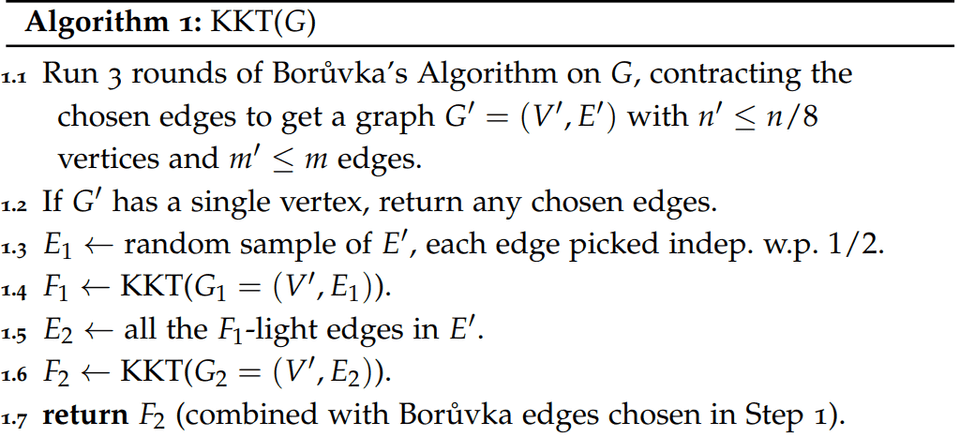KKT Algorithm
A randomized algorithm for finding the Minimum Spanning Tree in expected time. Created by Karger, Klein, Tarjan.
Definitions & Properties
- Forest - An undirected graph in which any two vertices are connected by at most one path. Can also be defined as an undirected graph with no cycles, or a graph with multiple trees as the components.
- Cut Rule - For any cut of the graph, the minimum-weight edge that crosses the cut must be in the MST. This rule helps us determine what to add to our MST.
- Cycle Rule - For any cycle in G, the heaviest edge on that cycle cannot be in the MST. This helps us determine what we can remove in constructing the MST.
- F-heavy - Let be a forest that is a subgraph of . An edge is said to be F-heavy if creates a cycle when added to , and is the heaviest edge in this cycle.
- F-light - An edge which is not F-heavy is F-light.
Heavy & Light edges Properties
- Edge is F-light . This essentially means that we can include when making the MST.
- If is an MST of , then edge is T-light if and only if .
- For any forest , the F-light edges contain the MST of the underlying graph . In other words, an F-heavy edge is also heavy with respect to the MST of the entire graph.
The last point implies that if we find the F-heavy edges for some forest that is a subgraph of , they will be heavy with respect to the minimum spanning tree of as well, hence we can discard them.
Hence, we can use a strategy of creating a random forest , finding and discarding all the F-heavy edges, and keep repeating till you have edges left.
To use this strategy, we need 2 things
- MST Verification - Given , how can we quickly classify an edge as heavy or light?
- Randomization - How do we ensure we find a forest with many F-heavy edges, ensuring that we discard many edges?
We’ll assume for now that we can output the set of all F-light edges of a forest in time .
Algorithm
Correctness
Claim - returns
We’ve already stated that removing the heavy edges of any forest in a graph doesn’t change the MST. Therefore, the MST of will be the same as the MST of .
We can then add the contracted edges of Boruvka’s algorithm and get the MST by the cut rule.
Claims
1.
At step , we are randomly sampling , which is of size . Since we are picking each edge with probability, by linearity of expectation, the expected number of edges in is
2.
To prove this, we look at the construction of in the perspective of Kruskal’s algorithm, making it more intuitive to analyze.
We sort all the edges in , and run a slightly modified Kruskal’s, iterating over edges , creating .
Useful - An edge is said to be useful in the current state if it connects two trees / doesn’t form a cycle.
Now, when we are iterating over , we first determine if the edge is useful or not. If it is useful, we then flip an unbiased coin, and include the edge in if we get heads, else we skip it.
We note that this algorithm is equivalent to step in the algorithm, hence we can analyze those steps indirectly by analyzing this modified Kruskal’s.
Number of heads required - Given there are nodes, the maximum number of edges we can include is , hence the maximum number of heads we can get is as well.
Expected number of coin flips - The probability of including a useful edge is , hence there is an expected number of flips before we get the maximum of edges. This also implies the expected number of useful edges is .
Now, we can easily claim that any non-useful edge is F-heavy, as it implies that it creates a cycle, and by the sorted order, it’s the largest edge on the cycle, hence it’s an F-heavy edge.
Therefore
Hence, the expected number of F-light edges is bounded by , proving the claim that .
Expected Running Time
We claim that expected running time of the algorithm with edges, vertices is .
Let be the expected running time on graph ,
Referring to the algorithm, we know that steps 1, 2, 3, 5, 7 all can be done in linear time, steps 4 and 6 are the ones we have to analyze.
We write the expected running time of steps 4 and 6 as respectively, and denote .
Hence, we can write the expected running time bound as
We inductively assume
Second Inequality: Properties Used -
We’ve already proven these properties
Third Inequality: Properties Used -
We know as we ran Boruvka’s thrice, and in each step, the number of vertices are at least halved in every step.
The second property is trivial as the number of edges reduce whenever we run Boruvka’s.
Hence, we’ve inductively proven that this bound holds, proving the claim that the expected running time is .
